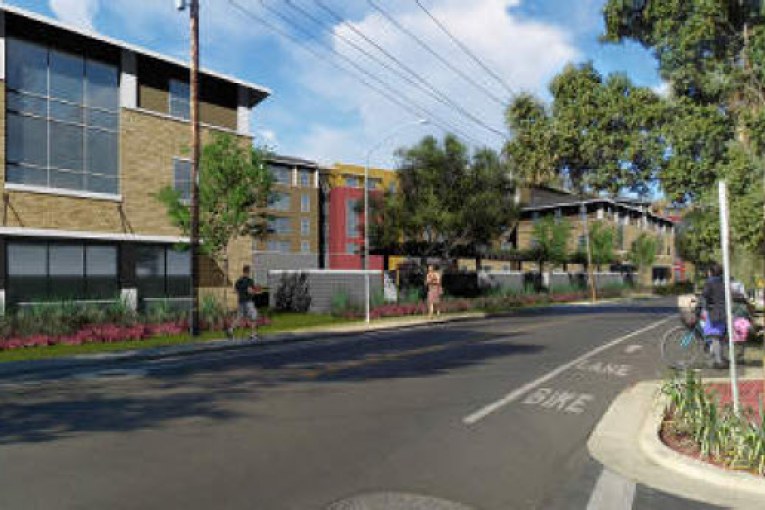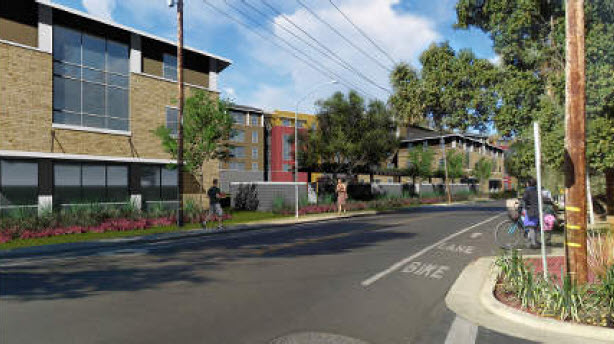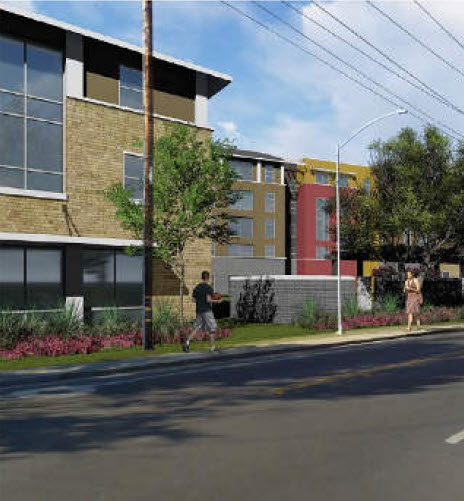

On Wednesday, the Lincoln40 project goes to the Planning Commission which will be asked to recommend to the council that that they certify the EIR as well as approve the Lincoln40 project planning applications.
The request is to approve a 130-unit student oriented apartment building with 708 beds, a bike barn, parking areas, swimming pool, and various amenities.
There are currently 24 dwelling units on the site. These consist of 10 single-family homes and a 14-unit apartment complex. The proposal would result in a net increase of 106 units over the  existing conditions.
existing conditions.
The first floor will include: the lobby, manager’s and leasing office, model unit, mailroom, 15 residential units, a game/theater room, multiple lounges and study spaces, a fitness center, a bike shop, indoor bicycle storage, and three restroom facilities.
The remaining floors would contain the remainder of the residential units along with study spaces.
The proposed project “would include a mix of two-bedroom to five-bedroom fully furnished units, each approximately 1,024 to 1,797 sf in size. The proposal would include 473 bedrooms, of which, 235 bedrooms would be designed as double-occupancy rooms resulting in 708 beds. Double-occupancy would not be allowed in any other rooms. It should also be noted that no more than two tenants would be allowed in double-occupancy rooms.”
The proposed project would be leased by the bed and not by the unit. “For each lease, the tenant would be assigned a unit and the tenant’s specific bedroom and given personalized access rights to the common areas, which are pool area, clubhouse, study rooms, secured bike areas and main apartment building.”
In addition to the rental units, the project includes 240 vehicle parking spaces and 708 bicycle parking spaces.

The staff report notes: “Staff cannot identify any significant issues with the proposed project.”
Staff notes that the infill project is determined to be a transit priority project by both staff and SACOG (Sacramento Area Council of Governments). In addition, “the analysis in the project EIR supports the conclusion that the proposed project meets the criteria set forth in Public Resources Code section 21155.1 to be declared a sustainable communities project by the City Council requiring no further CEQA review.”
Staff writes that they have received numerous comments on the project and the EIR from neighbors, interested citizens, and commissions during various public meetings and outreach. They believe most comments have been fully addressed in the Final EIR.
However, staff goes into detail addressing issues of policy, land use, development standards and site plan.
There are concerns about traffic and circulation issues, which staff believes “the EIR has adequately addressed.” They write: “No new evidence has been provided to refute the expert analysis and mitigation measures in the EIR to support the claim that this project would exacerbate the traffic and circulation situation at the Richards Boulevard and Olive Drive intersection if the proposed project applications were approved. An unsubstantiated assumption is not adequate to refute the analysis performed by trained experts.”
There is the issue of whether an overcrossing should be constructed prior to the project development.
Staff responds: “The construction of the overcrossing is a separate City decision, and a capital improvement project (CIP). It is not part of the proposed project.”
They note: “It cannot legally be required of the proposed project to bear the full cost of the overcrossing construction. However, this project will pay its fair share consistent with Government Code. A recommended condition of approval also requires the project to pay applicable development impact fees in accordance with City policies.”
The applicant has agreed through the development agreement “to contribute additional funds to the improvement of the overcrossing.”
Third, there were concerns that UC Davis should provide student housing, not the city. Staff notes that council passed a resolution in December 2016 that requested “UCD provide housing for a minimum of 100 percent of the projected student enrollment growth, and at least 50 percent of total UC Davis campus student population in the LRDP. This project will not prevent UC Davis from providing additional student housing.”
Staff notes: “There is a housing shortage in the City, and provision of an off campus student housing may provide some relief, especially to single-family homes currently being occupied by students in the City.”
Fourth, there are concerns about the displacement of residents. Staff notes that the council would have to balance the displacement of 15 tenants with city goals of providing infill housing and densification. Staff notes that they have received two tenant supportive comments and “no opposition comments by current residents.”
Fifth, there were concerns about the payment of in-lieu fees only, but staff notes that the applicant has revised their plan to include onsite affordable rental units and that in-lieu fees are no longer part of the plan.
There were also concerns about land use, namely density.
One issue was parking with the proposal to provide 240 parking spaces, which is fewer than the 256 minimum required by code.
Staff believes that “the recent movement toward reduced automobile usage and promotion of multi-modal transportation, including the use of rideshare such as Uber or Lyft, biking, walking, and Bus services, coupled with the location that is near campus and downtown, justify a favorable consideration of the proposal.”
On the other hand some suggested that “zero parking should be provided in order to discourage driving.” Staff does not “believe that it is a reasonable option since it may impose parking hardship in the area.”
There are complaints that 60 feet might be too tall. Staff responds, “The proposed building height is acceptable given the tiered height nature of the proposal and the fact that the 5th floor portion will be adjacent to the railroad, thus having a beneficial effect on the neighborhood and site; noise screening. As addressed in the EIR, there are no known adverse effects due to the 5-story portion of the building.”
On energy efficiency, there is a belief that the project should be a LEED Gold similar to Sterling Apartments, or LEED Gold certified.
Staff responds: “The applicant has agreed that the project will implement strategies necessary to achieve LEED Gold equivalent standards similar to Sterling. Conditions of approval and Development Agreement require the LEED Gold equivalent standards compliance…”
—David M. Greenwald reporting


A few thoughts from J Street, directly across the street from Lincoln40, 1/2 block removed from tracks.
1. “There is the issue of whether an overcrossing should be constructed prior to the project development.
Staff responds: “The construction of the overcrossing is a separate City decision, and a capital improvement project (CIP). It is not part of the proposed project.”
My concern is that the overcrossing may become a casualty specifically because it is not a part of the proposed project. I have expressed this concern directly to a representative of the developers who to date have been very forthcoming in addressing issues raised. Although, I am not sure of the meaning of this clause : “to contribute additional funds to the improvement of the overcrossing.” and think that clarification might be in order.
2.” provision of an off campus student housing may provide some relief, especially to single-family homes currently being occupied by students in the City.”
When making the final determination on this project, I would stress that both Commission and City Council note especially the word “may” provide some relief, which always should be read as “may or may not”. I see it as far from a slam dunk that this will have the intended relief on single family home availability and believe that it should be judged on the provision of student and young professional housing alone.
3.”there are concerns about the displacement of residents.”
This was and is a major concern of mine. I would like to make it widely known that the Lincoln40 developers have made extensive efforts to help find alternative housing for the those displaced.
4.”the applicant has revised their plan to include onsite affordable rental units”
A definite point in the developers favor along with their assistance to the displaced population.
5. I concur with the staff with regard to the transportation and parking issues.
6. “complaints that 60 feet might be too tall.”
While the staff’s assessment is may be valid from the point of view of Olive Drive, I do not believe that it adequately reflects the effects of those of us who live in very close proximity on the north side of the tracks. I recognize that there must be a weighing of the benefits and detriments to those who will be housed vs those who are currently housed in close proximity. I have had multiple discussions with representatives of the project, and although I am sure that we will be adversely affected to some degree, I believe that housing this many students in close proximity to the campus supersedes the annoyance that we will doubtless experience from the change in our street scape and noise levels. These developers, unlike some others, have worked extensively with those of us most directly impacted over time to attempt to lessen these impacts and that is truly appreciated.
In summary, at this point in time, although I would have preferred a mixed use, conforming project at this site, I am supportive of Lincoln40 due to its meeting the needs of a vulnerable segment of our population pending the commission hearing.
Without an overcrossing, this proposal shouldn’t even be considered. (For the students’ sake, as well as anyone using Richards/Olive.)
I understand that the developer proposed approximately 10% of beds to be “Affordable”, rather than 35% per city policy.
No mention of developer impact fees, which are also shortchanged by multi-bedroom proposals. Nor is there any mention of the lack of controls regarding water usage.
Wondering why this proposal is going before the planning commission, when other commissions had already raised unresolved concerns.
Per the quotes in the article, it seems like staff are “boosters” of the proposal. Should that be their “role”?
Tia:
”My concern is that the overcrossing may become a casualty specifically because it is not a part of the proposed project.”
My understanding is that there will be fees from this project and they are optimistic in getting grant funding, but yes, it has to be separate from this project because the developer here isn’t paying for the entire project and the grant funding is down the line somewhat.
Sounds like the city is hanging its hat (and approval process) on “down-the-line somewhat” optimism.
David
Thanks for the clarification, however, the issue still remains and I remain concerned because I share Ron’s concern about the overpass as critical to the mitigation project’s impact.
I would add that the overpass (or possibly an underpass – as previously mentioned on the Vanguard) must be designed in such a manner that it will be more “appealing” to cyclists and pedestrians, compared to existing street crossings.
Otherwise – it might not be used, for the most part.
Tia; The city doesn’t have money to fund the project without the grant, so they either don’t build the needed student housing immediately (which is a bad idea) or they hope that they get the grant funding (which they have every reason to believe they will get).
I support a grade separated crossing… but be fully aware that the day it is completed, it will require maintenance, and eventually repair. That requires GF money.
Personally, I think that a functional / well-designed grade-separated crossing is so important that the city should commit to it (and its ongoing maintenance), if they’re hell-bent on approving the proposal regardless of consequences.
A better idea would be to ensure that funding is in place, before approving the proposal.
Might also be a “good idea” to settle the entire issue regarding student housing with UCD in the first place, prior to “reacting” to UCD’s plans. On a related note, isn’t UCD due to make some “announcement” this month, regarding student housing on campus?
In case anyone “missed” it the other times I posted, here’s a link which describes some of the contributions that UC Santa Cruz is making toward traffic (and other) off-campus improvements. Wondering if a similar agreement with UCD might help address the cost of a grade-separated crossing for their students, for proposals such as Lincoln40:
http://lrdp.ucsc.edu/settlement-summary.shtml
Also wondering what this proposal, as well as the other megadorm proposals will cost the city – in the long run. For example, how much property tax will the city actually receive? Per a recent Vanguard article, the percentage varies significantly throughout the city, but seems to be around (an average?) of 20% of property taxes actually received by the city.
And, how much will properly allocated city services cost, both now and over time?
And, if the city is planning to contribute part of the cost of the needed overcrossing, how much will the city’s portion be?